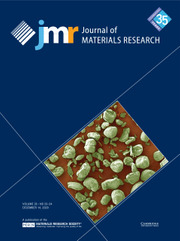Article contents
Influence of acetylene to argon flow rate ratios on structure and properties of hydrogenated amorphous carbon films produced on steel substrates by plasma immersion ion implantation and deposition
Published online by Cambridge University Press: 03 March 2011
Abstract
Hydrogenated amorphous carbon (a-C:H) films were fabricated using mixed acetylene and argon plasma with various flow rate ratios of acetylene to argon. Raman scattering and x-ray photoelectron spectroscopy show that changing the flow rate ratios (FC2H2 to FAr) has a large impact on the structure of the films. Enhanced film hardness and reduced surface roughness were achieved at higher ratios attributable to the high ion flux and efficient etching by hydrogen. However, the film surface exposed to atomic hydrogen at a higher C2H2 flow rate becomes rougher. The sp3 content and film hardness also reach saturation combined with a fissile surface due to the high stress.
Information
- Type
- Articles
- Information
- Copyright
- Copyright © Materials Research Society 2007
References
REFERENCES
1Dotto, M.E.R., Martins, R.N., and Ferreira, M., Camargo, S.S. Jr.: Influence of hydrogenated amorphous carbon coatings on the formation of paraffin deposits. Surf. Coat. Technol. 200, 6479 (2006).CrossRefGoogle Scholar
2Robertson, J.: Diamond-like amorphous carbon. Mater. Sci. Eng. Rep. 37, 129 (2002).CrossRefGoogle Scholar
3Liu, X.Y., Chu, P.K., and Ding, C.X.: Surface modification of titanium, titanium alloys, and related materials for biomedical applications. Mater. Sci. Eng. Rep. 47, 49 (2004).CrossRefGoogle Scholar
4Poon, R.W.Y., Yeung, K.W.K., Liu, X.Y., Chu, P.K., Chung, C.Y., Lu, W.W., Cheung, K.M.C., and Chan, D.: Carbon plasma immersion ion implantation of nickel-titanium shape memory alloy. Biomaterials 26, 2265 (2005).CrossRefGoogle Scholar
5Kwok, S.C.H., Wang, J., and Chu, P.K.: Surface energy, wettability, and blood compatibility phosphorus doped diamond-like carbon films. Diamond Relat. Mater. 14, 78 (2005).CrossRefGoogle Scholar
6Huck, H., Halac, E.B., Oviedo, C., Zampieri, G., Pregliasco, R.G., Alonso, E.V., Reinoso, M.E., and de Benyacar, M.A.R.: Characterization of amorphous carbon rich Si1−xCx thin films obtained using high energy hydrocarbon ion beams on Si. Appl. Surf. Sci. 141, 141 (1999).CrossRefGoogle Scholar
7Druz, B., Zaritskiy, I., Hoehn, J., Polyakov, V.I., Rukovishnikov, A.I., and Novotny, V.: Direct ion beam deposition of hard (>30 GPa) diamond-like films from RF inductively coupled plasma source. Diamond Relat. Mater. 10, 931 (2001).CrossRefGoogle Scholar
8Kumar, S., Rauthan, C.M.S., Srivatsa, K.M.K., Dixit, P.N., and Bhattacharyya, R.: Realization of different carbon nanostructures by a microwave plasma enhanced chemical vapor deposition technique. Appl. Surf. Sci. 182, 326 (2001).CrossRefGoogle Scholar
9Huang, L-Y., Xu, K-W., Lu, J., and Guelorget, B.: Analysis of nano-scratch behavior of diamond-like carbon films. Surf. Coat. Technol. 154, 232 (2002).CrossRefGoogle Scholar
10Voevodin, A.A., Walck, S.D., and Zabinski, J.S.: Architecture of multilayer nanocomposite coatings with super-hard diamond-like carbon layers for wear protection at high contact loads. Wear 203–204, 516 (1997).CrossRefGoogle Scholar
11Jayatissa, A.H., Sato, F., Saito, N., Hirano, Y., and Takizawa, K.: Characterization of diamond-like carbon clusters deposited by pulsed ArF laser deposition. Carbon 38, 1145 (2000).CrossRefGoogle Scholar
12Walter, K.C., Nastasi, M., and Munson, C.: Adherent diamond-like carbon coatings on metals via plasma source ion implantation. Surf. Coat. Technol. 93, 287 (1997).CrossRefGoogle Scholar
13Anders, A.: From plasma immersion ion implantation to deposition: A historical perspective on principles and trend. Surf. Coat. Technol. 156, 3 (2002).CrossRefGoogle Scholar
14Uzumaki, E.T., Lamber, C.S., and Zavaglia, C.A.C.: Diamond-like carbon coatings on Ti–13Nb–13Zr alloy produced by plasma immersion for orthopaedic applications. Key Eng. Mater. 254–256, 435 (2004).Google Scholar
15Liao, J.X., Liu, W.M., Xu, T., and Xue, Q.J.: Characteristics of carbon films prepared by plasma-based ion implantation. Carbon 42, 387 (2004).CrossRefGoogle Scholar
16Zeng, Z.M., Zhang, T., Tian, X.B., Tang, B.Y., Kwok, T.K., and Chu, P.K.: Surface modification of 9Cr18 bearing steels by a metal and carbon co-plasma immersion ion implantation. Surf. Coat. Technol. 128–129, 236 (2000).CrossRefGoogle Scholar
17Shinno, H., Ishioka, K., and Kitajima, M.: Deposition of carbon films by plasma-based ion implantation using glow discharge plasma ignited by high voltage pulses applied to substrates. Vacuum 66, 335 (2002).CrossRefGoogle Scholar
18Baba, K. and Hatada, R.: Formation of amorphous carbon thin films by plasma source ion implantation. Surf. Coat. Technol. 103–104, 235 (1998).CrossRefGoogle Scholar
19Logothetidis, S., Charitidis, C., Gioti, M., Panayiotato, Y., Handrea, M., and Kautek, W.: Comprehensive study on the properties of multilayered amorphous carbon films. Diamond Relat. Mater. 9, 756 (2000).CrossRefGoogle Scholar
20Di, Z.F., Huang, A.P., Fu, R.K.Y., Chu, P.K., Shao, L., Höchbauer, T., Nastasi, M., Zhang, M., Liu, W.L., Shen, Q.W., Luo, S.H., Song, Z.T., and Lin, C.L.: Thermal stability of diamondlike carbon buried layer fabricated by plasma immersion ion implantation and deposition in silicon on insulator. J. Appl. Phys. 98, 053502 (2005).CrossRefGoogle Scholar
21Chu, P.K. and Li, L.H.: Characterization of amorphous and nanocrystalline carbon films. Mater. Chem. Phys. 96, 253 (2006).CrossRefGoogle Scholar
22McCulloch, D.G., Prawer, S., and Hoffman, A.: Structural investigation of xenon-ion-beam-irradiated glassy carbon. Phys. Rev. B 50, 5909 (1994).CrossRefGoogle ScholarPubMed
23Tamor, M.A. and Vassell, W.C.: Raman “fingerprinting” of amorphous carbon. J. Appl. Phys. 76, 3823 (1994).CrossRefGoogle Scholar
24Chen, J.Y., Wang, L.P., Fu, K.Y., Huang, N., Leng, Y., Leng, Y.X., Yang, P., Wang, J., Wan, G.J., Sun, H., Tian, X.B., and Chu, P.K.: Blood compatibility and sp 3/sp 2 contents of diamond-like carbon (DLC) synthesized by plasma immersion ion implantation-deposition. Surf. Coat. Technol. 156, 289 (2002).CrossRefGoogle Scholar
25Rusli, , Yoon, S.F., Yang, H., Zhang, Q., Ahn, J., and Fu, Y.L.: Effect of pressure on the deposition of hydrogenated amorphous carbon films using the electron cyclotron resonance chemical vapor deposition. J. Vac. Sci. Technol., A 16, 572 (1998).CrossRefGoogle Scholar
26Li, X.D. and Bhushan, B.: Measurement of fracture toughness of ultra-thin amorphous carbon films. Thin Solid Films 315, 214 (1998).CrossRefGoogle Scholar
27Li, X.D., Diao, D.F., and Bhushan, B.: Fracture mechanisms of thin amorphous carbon films in nanoindentation. Acta Mater. 45, 4453 (1997).CrossRefGoogle Scholar
28Peng, X.L., Barber, Z.H., and Clyne, T.W.: Surface roughness of diamond-like carbon films prepared using various techniques. Surf. Coat. Technol. 138, 23 (2001).CrossRefGoogle Scholar
- 1
- Cited by

